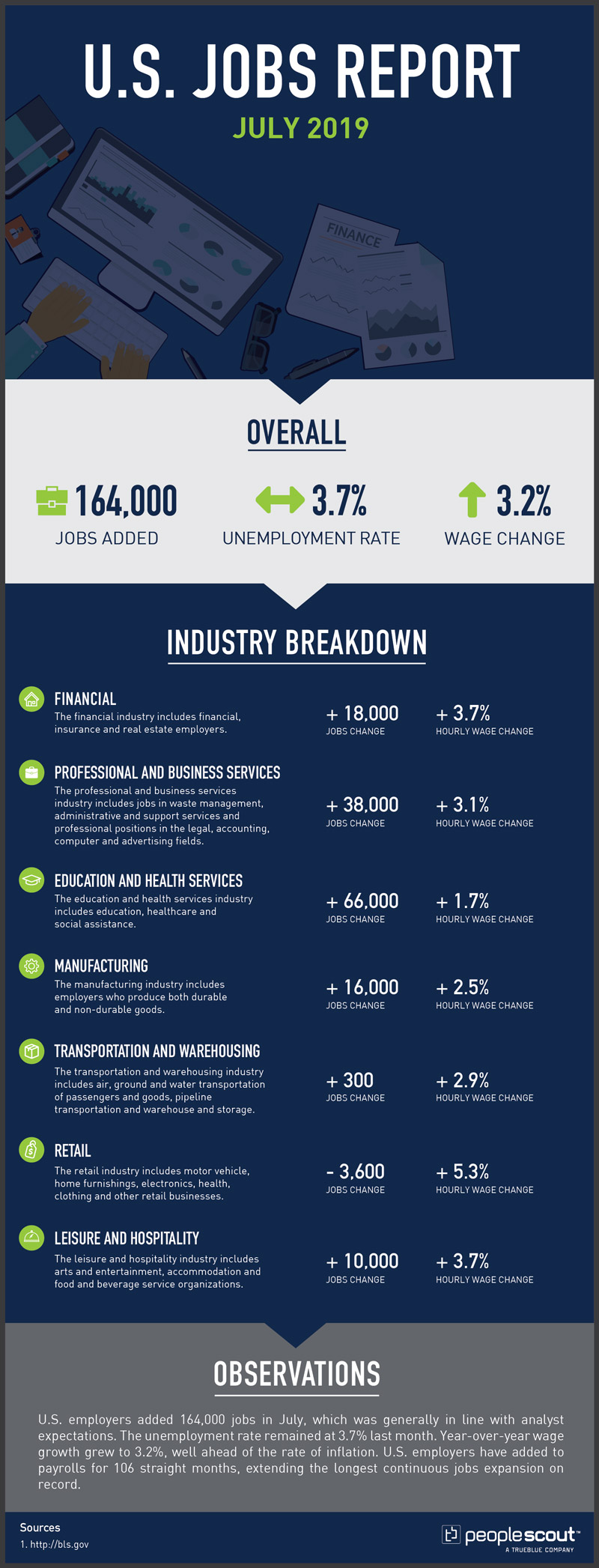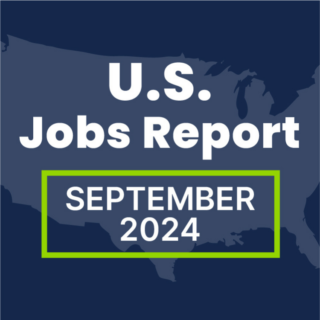The Labor Department released its July jobs report which shows that U.S. employers added 164,000 jobs in July, in line with many analyst expectations. The unemployment rate stayed at 3.7%. Year-over-year wage growth grew to 3.2%, well ahead of the rate of inflation. U.S. employers have added to payrolls for 106 straight months, extending the longest continuous jobs expansion on record.

The Numbers
164,000: The economy added 164,000 jobs in July.
3.7%: The unemployment rate remained at 3.7%.
3.2%: Wages increased at a rate of 3.2% over the last year.
The Good
The longest continuous job expansion in the nation’s history extended another month with 164,000 new jobs added to the economy. The unemployment rate remained at 3.7%, a figure close to historic lows. Year-over-year earnings increased to a healthy 3.2%.
There was also good news for those who were working part-time out of economic necessity. The number of persons employed part-time for economic reasons (sometimes referred to as involuntary part-time workers) declined by 363,000 in July to 4.0 million. These individuals, who would have preferred full-time employment, were working part-time because their hours had been reduced or they were unable to find full-time jobs. Over the past 12 months, the number of involuntary part-time workers has declined by an impressive 604,000.
Among the marginally attached, there were 368,000 discouraged workers in July, down by 144,000 from a year earlier. Discouraged workers are those not currently looking for work because they believe no jobs are available for them. The remaining 1.1 million persons marginally attached to the labor force in July had not searched for work for reasons such as school attendance or family responsibilities. The decrease in discouraged workers reflects that confidence that enough jobs have been created to lure these individuals back into the workforce.
The Bad
The rate of job growth is definitely slowing. Over the first seven months of the year, the economy added 165,000 jobs a month, on average, below 2018’s average monthly pace of 223,000. The July report also shows a fall in the number of hours worked. The average workweek for all employees on private nonfarm payrolls decreased by 0.1 hour to 34.3 hours in July. In manufacturing, the average workweek decreased by 0.3 hour to 40.4 hours, and overtime declined by 0.2 hour to 3.2 hours. The decline in manufacturing hours can be attributed to uncertainty caused by the tariffs on foreign goods which have been growing on key trading partners like China.
While this slowing rate of growth may not be a cause for concern, the slowing rate combined with reduced hours has provoked pessimistic responses from some analysts:
“If I were to give a grade to the July employment report it would be a gentlemen’s C: Three-month average has declined to 140K, the downward revisions to May and June, and that decline in hours worked, which impacts your median household, is not encouraging.”
The Unknown
While 106 months of continuous job expansion is certainly viewed as good news for American workers, this extended job growth has increased competition among employers for increasingly scarce talent. One sector that has been most impacted by the tight labor market is hospitality. As the New York Times reported on the challenges employers face as part of its reporting on the July jobs report:
“A survey of business owners last month by the National Federation of Independent Business found job creation remains at a historically high level.
Ask pretty much any general contractor, hospital leader or restaurant owner about his or her biggest headaches, and a lack of qualified workers comes up.
‘Ten percent of our positions are always open,’ said Ignacio Garcia-Menocal, a co-founder and chief executive of Grove Bay Hospitality, which operates several celebrity-chef restaurants and employs 450 people. With two restaurants opening soon, Mr. Garcia-Menocal said he was looking to hire 40 to 50 people, from dishwashers who start at $10 an hour to general managers, whose salaries can range from $70,000 to $90,000 a year.”
It is unclear how long many businesses can continue operating normally with job vacancy rates at 10% or even higher. In the short term, these businesses could incur higher overtime costs and increased wage demands as they ask their employees to perform at greater efficiency. In the long-term, many enterprises will need to re-think their recruitment and retention strategies if they want to remain profitable in the most challenging labor market in recent memory.




